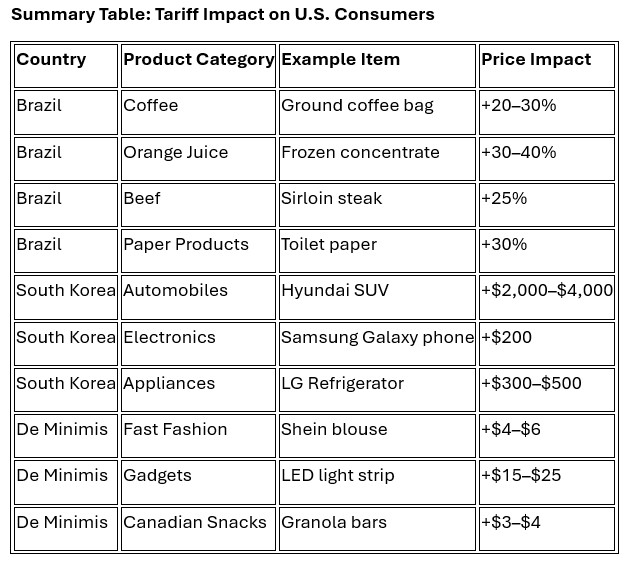U.S. Trade Policy Overhaul: Tariffs on Brazil and South Korea, and the End of De Minimis
The United States has initiated a sweeping transformation of its trade policy under President Donald Trump, marking a decisive pivot toward economic nationalism and protectionism. This shift includes the imposition of steep tariffs on Brazil and South Korea two major trading partners and the dismantling of the de minimis exemption, a long-standing provision that allowed low-value imports to enter the U.S. duty-free. These actions are not isolated; they represent a broader strategy aimed at reshoring manufacturing, asserting geopolitical influence, and recalibrating global supply chains.
The implications are profound. From diplomatic tensions and economic disruptions to shifts in consumer behavior and corporate strategy, the ripple effects of these policies are already being felt across continents.
Tariffs on Brazil: Political Retaliation and Economic Consequences
Background and Justification
On July 30, 2025, President Trump signed an executive order imposing a 50% tariff on all Brazilian imports. This move was justified on grounds of national security and human rights, specifically targeting Brazil’s judicial actions against former President Jair Bolsonaro. Bolsonaro, a close ally of Trump, is currently facing trial for allegedly attempting to stage a coup following his 2022 electoral defeat.
The executive order accuses the Brazilian government of politically motivated persecution, censorship, and intimidation. It singles out Supreme Court Justice Alexandre de Moraes, who has been sanctioned by the U.S. Treasury and subjected to visa restrictions. The administration claims these actions undermine the rule of law and violate the free speech rights of U.S. persons.
Economic Impact on Brazil
The 50% tariff is expected to severely disrupt Brazil’s export economy, particularly in sectors where it holds competitive advantages:
- Coffee: Brazil supplies 30% of U.S. coffee imports. The tariff could generate $2.1 billion in additional costs for U.S. importers, potentially reducing demand and hurting Brazilian farmers.
- Iron Ore: With 15% of U.S. steel inputs sourced from Brazil, the tariff could add $4.35 billion in costs, impacting both Brazilian miners and U.S. manufacturers.
- Soybeans and Sugar: These agricultural staples face similar barriers, with projected revenue losses exceeding $3 billion.
- Wood Pulp and Ethanol: Brazil’s dominance in cellulose and biofuels is threatened, with tariffs expected to reduce export volumes and profitability.
Overall, economists estimate a 0.3–0.4% decline in Brazil’s GDP, with over 100,000 jobs at risk. The agribusiness sector, which relies heavily on U.S. demand, could see exports cut in half.
Political Response from Brazil
President Luiz Inácio Lula da Silva has condemned the tariffs as “unacceptable blackmail,” asserting Brazil’s sovereignty and rejecting any linkage between trade and judicial proceedings. Lula has signaled a potential pivot toward China and other BRICS nations, emphasizing that Brazil will not negotiate under duress.
Brazil’s Attorney General and trade officials have labeled the sanctions and tariffs as a “serious attack” on national sovereignty. While official retaliation has not yet been announced, Brazil is exploring alternative markets and trade alliances to mitigate the impact.
Tariffs on South Korea: Strategic Deal-Making and Domestic Fallout
The 15% Tariff Agreement
South Korea narrowly avoided a harsher 25% tariff by negotiating a last-minute deal with the U.S. The agreement includes:
- A 15% tariff on South Korean exports to the U.S.
- A commitment to invest $350 billion in U.S. infrastructure, manufacturing, and technology sectors.
- A pledge to purchase $100 billion in American energy products, including liquefied natural gas (LNG).
- An agreement to accept U.S. exports such as vehicles, agricultural goods, and pharmaceuticals without imposing reciprocal tariffs.
This deal was framed by the Trump administration as a “reciprocal trade arrangement,” designed to rebalance trade deficits and promote American industry.
Domestic Challenges in South Korea
President Lee Jae Myung faces significant political backlash at home. Key concerns include:
- Agricultural Sector: Farmers are protesting the increased access granted to U.S. agricultural products, fearing market saturation and price declines.
- Manufacturing and Automotive Industries: South Korea’s export-heavy economy must absorb higher costs, potentially reducing competitiveness in the U.S. market.
- Political Opposition: Critics argue that the deal sacrifices long-term trade equity for short-term diplomatic appeasement.
Despite these challenges, the agreement has temporarily shielded South Korea from deeper penalties and preserved its strategic partnership with the U.S.
Strategic Implications
The deal strengthens U.S.-South Korea economic ties but raises questions about fairness and sustainability. By allowing the U.S. to dictate terms, South Korea risks setting a precedent that could affect future negotiations with other nations.
Moreover, the investment commitments while substantial lack clarity on implementation timelines and oversight mechanisms. Analysts warn that without transparent governance, these pledges could become politically symbolic rather than economically transformative.
Elimination of the De Minimis Exemption: A Blow to Global E-Commerce
What Is the De Minimis Exemption?
The de minimis exemption allowed imports valued under $800 to enter the U.S. duty-free. Originally designed to reduce administrative burdens, it became a cornerstone of global e-commerce, enabling platforms like Temu, Shein, and AliExpress to ship low-cost goods directly to American consumers.
In 2024 alone, over 1.36 billion low-value packages entered the U.S. under this provision a 600% increase from a decade earlier.
Policy Changes and Timeline
Under the One Big Beautiful Bill Act, the de minimis exemption will be fully repealed by July 1, 2027. Key milestones include:
- May 2, 2025: Exemption suspended for China and Hong Kong.
- August 29, 2025: All other countries subject to flat-rate tariffs of $80–$200 per shipment.
- July 1, 2027: Full repeal of de minimis for all commercial imports.
The repeal is justified on grounds of national security, with the administration citing abuse of the exemption by foreign entities and the need to protect American businesses.
Impact on Businesses and Consumers
The elimination of de minimis is expected to disrupt global supply chains and reshape consumer behavior:
- Chinese Exporters: Companies are rerouting shipments through Mexico and Canada or building U.S. warehouses to avoid tariffs.
- Canadian Businesses: Facing both the loss of de minimis and new 25% tariffs, Canadian exporters are reassessing their U.S. strategies.
- E-Commerce Platforms: Temu and Shein have raised prices and begun stockpiling inventory. Some are shifting to bulk shipping models or investing in domestic fulfillment centers.
- U.S. Consumers: Prices for low-cost goods will rise, and delivery times may increase due to customs delays and supply chain restructuring.
Legal challenges are underway. Detroit Axle, a U.S. auto parts importer, has filed suit against the administration, arguing that the repeal violates the Administrative Procedure Act and should have undergone formal rule-making.
Brazilian Imports: Everyday Items Facing Steep Price Hikes
Brazil is a major supplier of agricultural and industrial goods to the U.S. The 50% tariff will significantly raise costs on several popular items:
Coffee
- Impact: Brazil supplies 30% of U.S. coffee imports.
- Consumer effect: Expect a 20–30% increase in retail coffee prices, especially for brands using Brazilian beans like Café Pilão or Lavazza blends.
- Example: A $10 bag of ground coffee could jump to $13 or more.
Orange Juice
- Impact: Brazil is a top exporter of frozen orange juice concentrate.
- Consumer effect: Prices for breakfast staples like Tropicana and Minute Maid may rise, especially for pulp-rich varieties.
- Example: A $4 bottle could increase to $5.50.
Beef and Poultry
- Impact: Brazil is the second-largest beef exporter to the U.S.
- Consumer effect: Higher prices for lean cuts and processed meats, including frozen steaks and canned corned beef.
- Example: A $12 sirloin could cost $15–$16.
Wood Pulp and Paper Products
- Impact: Brazil supplies 40% of U.S. cellulose imports.
- Consumer effect: Increased costs for toilet paper, tissues, and paper towels.
- Example: A 12-pack of toilet paper could rise from $8 to $10.50.
South Korean Imports: Electronics, Vehicles, and Appliances Hit Hard
South Korea’s 15–25% tariffs will affect high-tech and consumer goods that are staples in American households:
Automobiles
- Impact: Hyundai and Kia vehicles face 25% tariffs.
- Consumer effect: New car prices could rise by $2,000–$4,000, especially for popular models like the Hyundai Tucson or Kia Sportage.
- Example: A $28,000 SUV could cost $32,000.
Electronics
- Impact: Samsung and LG products phones, TVs, appliances are heavily affected.
- Consumer effect: Expect 10–20% price hikes on smartphones, refrigerators, and washing machines.
- Example: A $1,200 Samsung Galaxy phone could cost $1,400.
Semiconductors and Batteries
- Impact: Tariffs on components used in EVs and laptops.
- Consumer effect: Higher prices for electric vehicles and tech devices, including Dell laptops and Tesla models using Korean batteries.
De Minimis Repeal: E-Commerce and Small Parcels Disrupted
The end of the de minimis exemption means all imports under $800 will now face duties, starting with China and Hong Kong and expanding globally by 2027.
Fast Fashion and Accessories
- Impact: Platforms like Shein and Temu relied on duty-free shipping.
- Consumer effect: Prices for clothing, jewelry, and accessories will rise 15–40%, and shipping may slow.
- Example: A $12 blouse could cost $16–$18.
Household Goods and Gadgets
- Impact: Items like LED lights, phone cases, and kitchen tools.
- Consumer effect: Flat fees of $80–$200 per shipment will be passed to consumers.
- Example: A $25 gadget may now cost $40–$50 after duties and fees.
Canadian Specialty Foods
- Impact: Canadian snacks, maple syrup, and organic goods lose duty-free status.
- Consumer effect: Higher prices and fewer small-batch imports.
- Example: A $9 box of granola bars could cost $12–$13.

Conclusion: Trade as a Tool of Power
The U.S. tariff actions on Brazil and South Korea, coupled with the elimination of the de minimis exemption, reflect a broader strategy of using trade policy as a geopolitical lever. While these measures may bolster certain domestic industries and assert American influence, they also risk inflaming diplomatic tensions, disrupting global commerce, and increasing costs for consumers.
As the world adjusts to this new era of trade nationalism, businesses, governments, and consumers alike must navigate a landscape defined by uncertainty, strategic recalibration, and the growing intersection of politics and economics.

